This substack is self-funded and each newsletter takes time to research, photograph and write. It’d be very helpful if you could become a paid subscriber as gift for yourself or a Christmas present. Chokh mamnoon.
Tomorrow morning, Saturday the 21st of December at 9.21, in the UK is the exact moment when our little planet tilts back toward the sun, leading to longer days and shorter nights in the northern hemisphere. This is the winter solstice, from then on, the light will return, and days will gradually grow longer. For many peoples, this was seen as the rebirth of the sun, symbolizing the victory of light over darkness. Light represented life, whilst darkness was where danger or malevolent spirits resided. Fires were lit and are a significant element of this festivities to give warmth, light and beauty.

Different cultures have their own names for this celebration. For us Azeris, it’s called chilla jejasi (the night of chilla). There’s quite a bit of debate about the origins of the word chilla. Some believe it’s tied to the longest 40 days of winter or the number of days until next festival, Sadeh. Others suggest it refers to the night being drawn out like a bowstrings and I read somewhere it was the Azeri name of the month which starts on the winter solstice. The number 40 held symbolic importance for our forebears, not as an exact count but as a way to represent a substantial yet not huge number. We also see this significance in religious stories, like 40 days and nights or the tale of Ali Baba and the 40 thieves.
In Persianate societies, it night is called Shabe Yalda, the night of Yalda, a term with roots in the ancient Aramaic origin of the Arabic word for "birth." Yalda marks the birthday of the deity Mitra. In Turko-Mongolian regions, it’s called Nardoghma or the “birth of the sun.” In Turkic languages, nar also means pomegranate, so Nardoghma could be translated as "pomegranate birth." Pomegranates come with their own set of stories, sayings, and folklore, which I’ll cover in another newsletter. For now, though, the pomegranate symbolises many things such as the sun, with it being round and colours ranging from yellow and orange to red, the shiny arils inside are seen as glistening rays of light. The 13th century Irani poet Sa’di, in his Boostan says
صبح صادق ندمد تا شب يلدا نرود
The honest morning will not approach until Yalda has passed
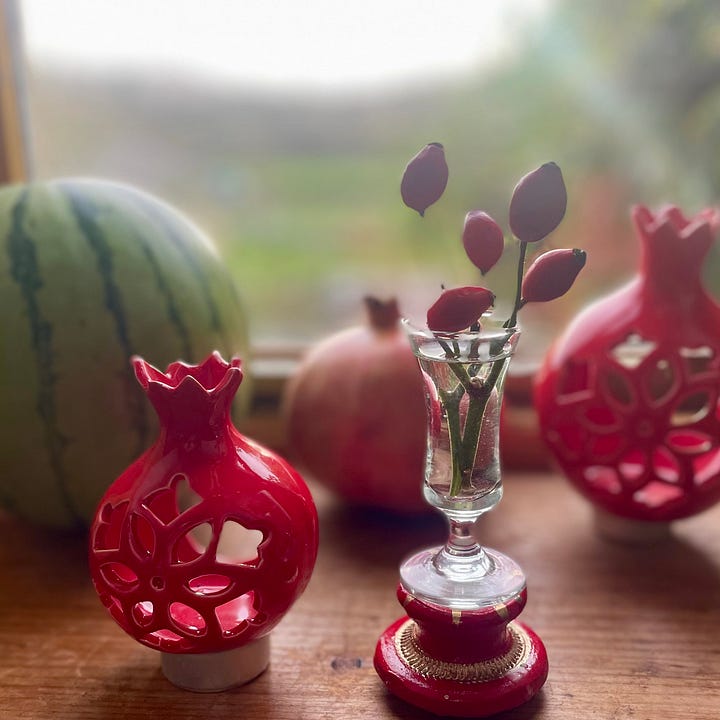

At this time giving thanks for getting through the hardships of winter with acts of charity, like giving alms, were a part of many traditions, which has now evolved into gift-giving. In Azerbaijan, children and brides-to-be receive chillalukh or “chilla gifts.” In the past, families would prepare elaborate khoncha, large trays filled with seasonal foods and new clothes. These were sent from the groom’s family to the fiancée. Nowadays, instead of dried fruits, nuts, and clothes, it’s more likely to be mobile phones and chocolates.
When I’m in Tabriz during chilla jejasi, I love walking through the neighbourhood looking for decorated trays of pomegranates and sweets or watermelon tied up with ribbons as chillalukh. It’s lovely to see excited givers delivering these trays and thrilled recipients answering the door. After the girl is married her family bring chillalukh. More recently it has become very commercialised with pomegranate themed cakes, balloons and street decorations.
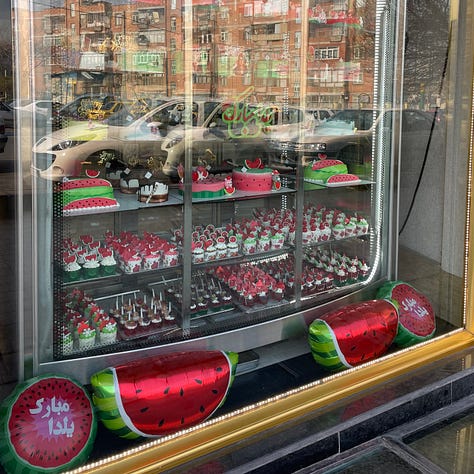
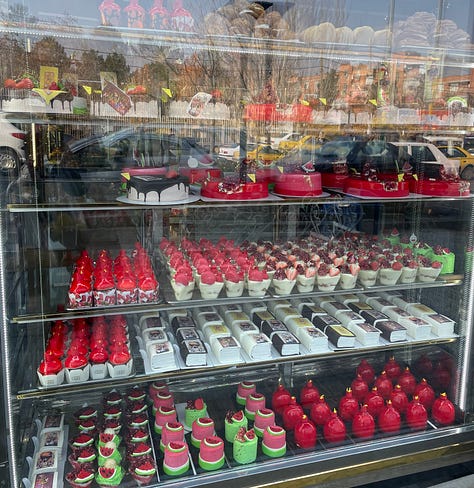
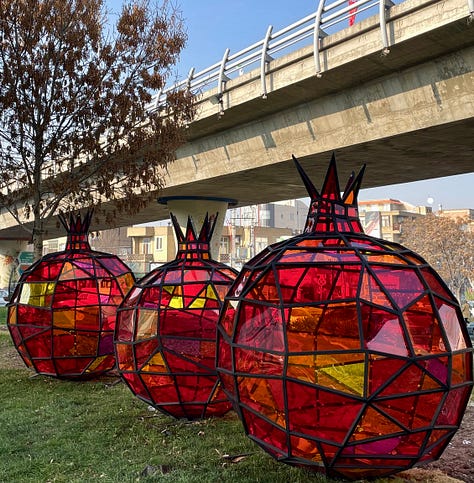
Before the days of central heating, life in winter was spent literally around the chursi, from the Arabic word for chair. Wealthier households might have had fireplaces in every room, however, most people in Azerbaijan spent the winter months gathered around the chursi to work, socialize, and sleep. Winters there are bitterly cold, and my mum recalls that a glass of water would sometimes freeze overnight if left by the window.
When we visit old houses we see a reminder of this lifestyle, in the form of a shallow indent in the centre of the room. In this space, they’d place a brazier filled with embers, carefully topped with a layer of ash. Over this brazier, they set a low table, about a meter square, high enough to avoid scorching underneath. The coals had to be expertly prepared in the garden to prevent the risk of carbon monoxide poisoning.
The table would be covered with a sheet and then with a chursi yorgani, a special, oversized blanket made just for this purpose. These blankets were handmade and quite heavy, filled with sheep’s wool sewn into sections to keep the filling evenly distributed. The outer layer was often good-quality white cotton, with a satin or floral panel at the centre. The blanket was so large it would stretch out to the walls of the room, creating a cozy snug. The chursi wasn’t just a source of warmth; it was the heart of the home during those long, cold winters.
Around the edges of the room, along three walls, were doshayh or mattresses similar to futons but stuffed with sheep’s wool, one for each family member. Covered with sheets, they served as seating during the day and sleeping spaces at night. To lean against, the walls were lined with mitacha and balish, large cushions and bolsters. The side closest to the door was where the children or the host would sit, with a samāvar nearby.
On top of the chursi yorgani, there would be a decorative chursi usti, a beautiful large sheet, followed by the sufra or tablecloth, where all the snacks and treats were laid out. I remember in the late 80’s in my parents modern 2nd floor apartment, we put a small table, with a low wattage light attached to the bottom to be the heat source rigged up by my Hossain Dai as our chursi. It was in a central small room with no windows to the outside and where we’d spend evening doing our homework during the war. When the sirens would go and there were blackouts, we’d light several nafti chiragh or kerosene lamps for light and carry on as usual.
My mother’s Oskoui family has always been incredibly close and loving (mashallah, may they always stay that way in good health and happiness). When she was young they’d gather at each other’s homes after dinner three to four times a week for snacks and a catch-up called shab chara. Chilla jejasi was and is a special extended shab chara held at the home of the family elder.
The snacks for this night were more distinct such as candy floss, fresh fruit especially pomegranates, the symbol of the evening and sweet limes citrus limetta. If you see these round, yellow limes about the size of a small orange in specialist shops at this time of year, you must try one. We would roll them around to make the fruit squishy, then pierce a hole to the centre of the fruit. Then we’d hold it agains our mouth and squeeze and suck the juice. The fruit oxidizes and goes bitter. Eat it as soon as you cut it.
There would also be bowls of nokhod chishmish or dried fruits of the vine and chic peas and other dried fruit from our own bogh. Dried peaches, nectarines, and apricots known as gākh and of course eeda fruit of the oleaster tree. All sorts of nuts, seeds and grains were toasted and are still popular known as gowurga which is wheat but can also have apricot kernels, hemp seeds and lentils.
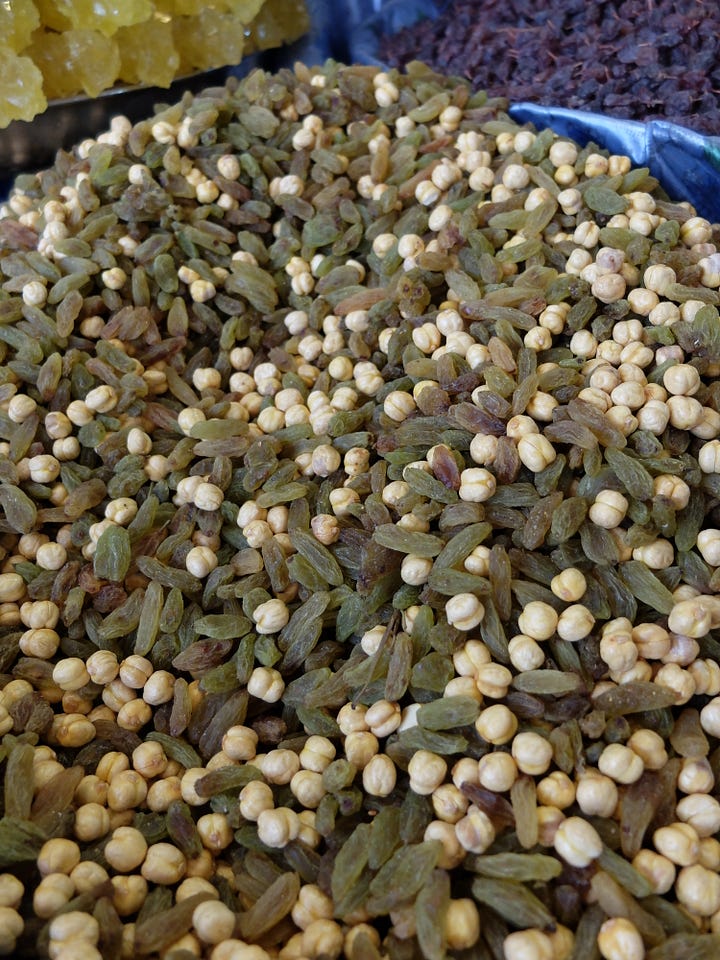
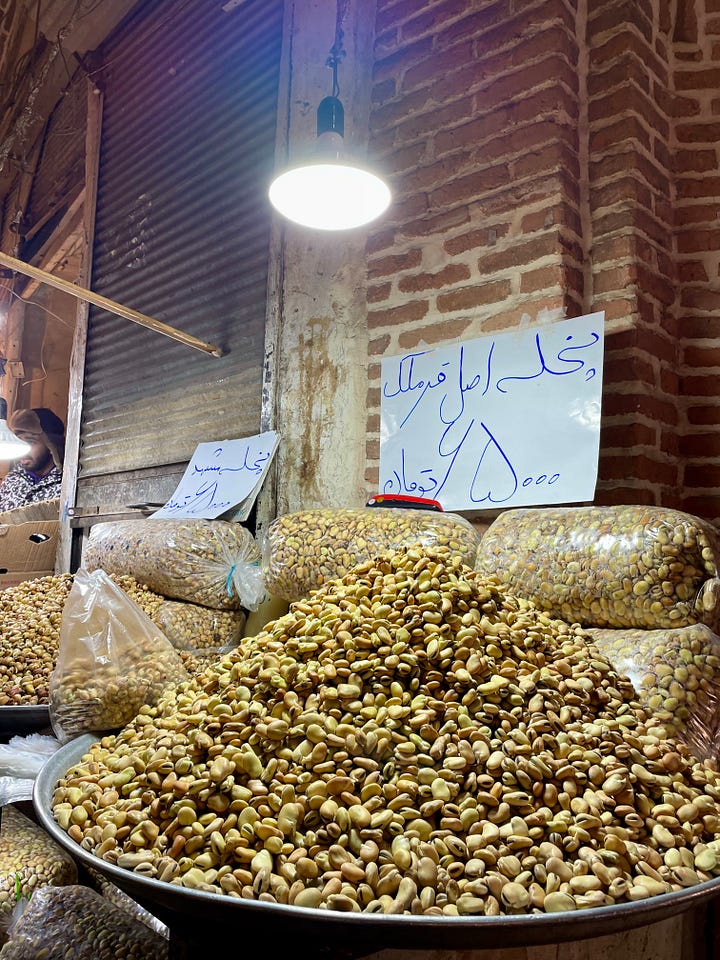
My favourite of these seeds is what I like to call my “tobacco”, toasted sunflower seeds in the shell, or simishka. They’re as noisy and messy to eat as they are addictive. My sister, dad, and I would go through kilos of them! The noise of cracking them open is the background soundtrack in Iranian cinemas. I love simishka. Whenever I visit home, mum buys good-quality raw seeds kham simishka and toasts them fresh for me.
Then there is unseasonal watermelon. Stored carefully to last until this night, it’s cut and shared as a summer fruit eaten in defiance of the long, dark night. There is great anticipation when it is cut open to see if it has lasted the storage or not. Another highlight is shani turshisi, pickled shani grapes. This could be a remnant of the region’s ancient wine culture, after all it is where viticulture began. The pickle is mildly tangy with little to no alcohol, but it’s a unique treat. My pickled crab apples would also be suitable, recipe here.
Other treats on my family’s sufra are boiled beetroot and dried broad beans which are also common street food or snacks in the winter. One time we were having broad beans and my sister said the water looked like the liquor as jorab sui, sock washing water much to mum’s embarrassment. Whenever we have it we remember that. All these snacks are washed down with perfectly brewed, amber coloured tea from the samāvar.
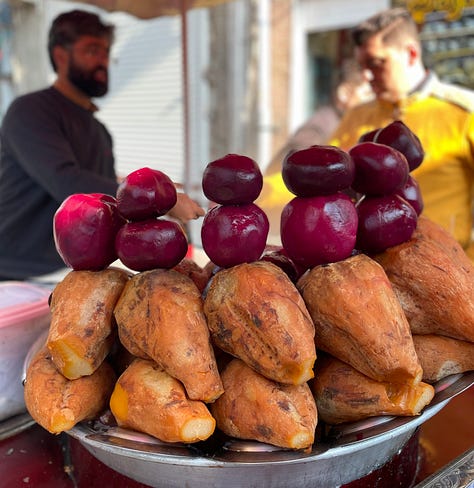

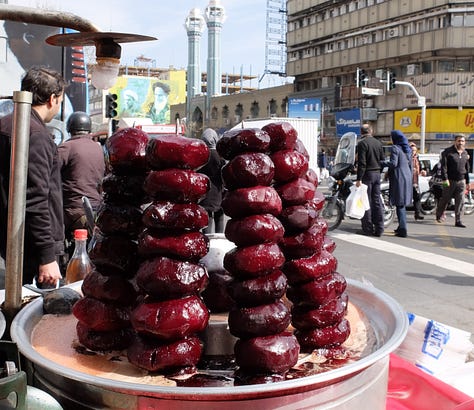
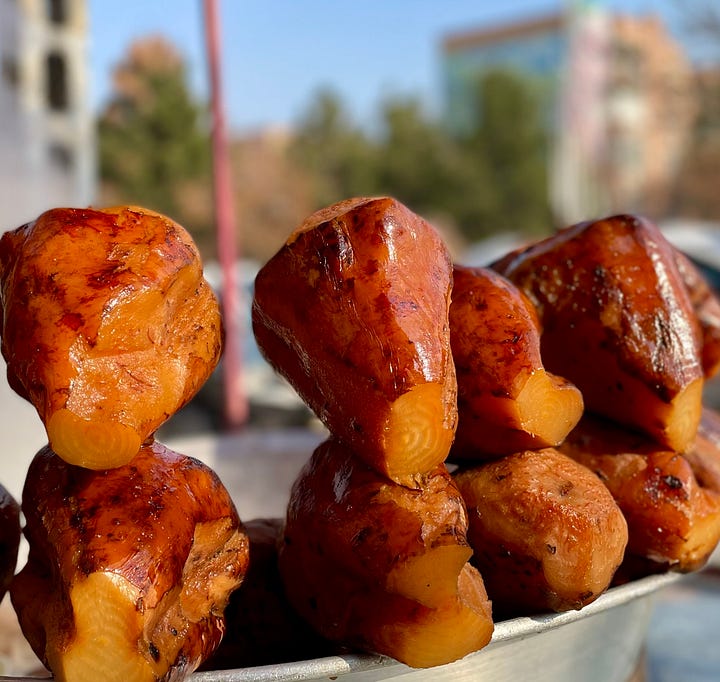
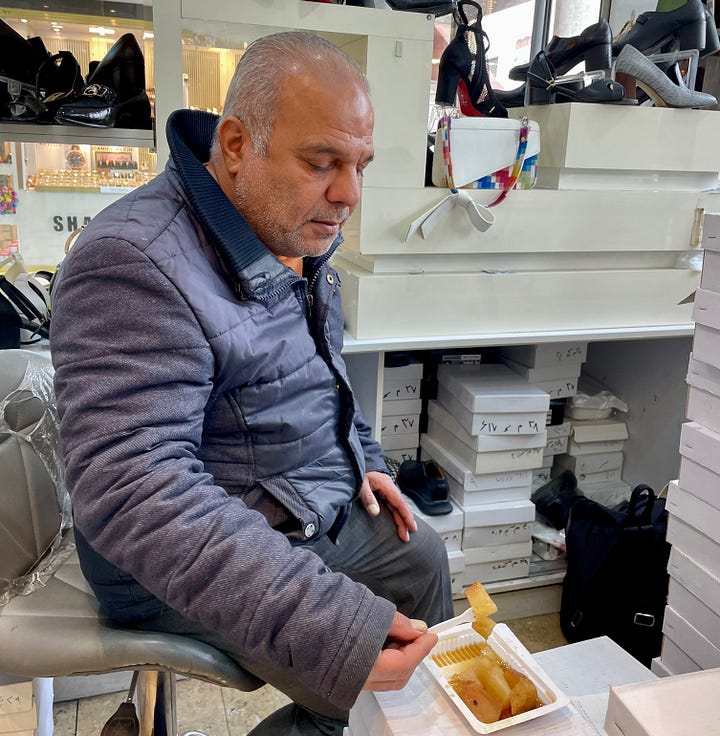
I would’ve loved to have been at mum’s childhood chilla jejasi gatherings, with her brothers, my uncles, messing around and the food they enjoyed. She told me how they’d dry alcha or gages in the summer, picked with the stalks intact. The stalks would be bound with string around a stick, and left in a dark, airy place for the winter. They must’ve looked so beautiful. On chilla jejasi, they’d rinse and eat them, but as kids, they had a mischievous game. They’d suck out the insides, blow the skins back up, and leave them on a plate. When someone else picked them up, they’d deflate in their hand. The victim would grumble, “Boshdi t’s empty!” or “Gabokhdi it’s just skin!” to the giggles of everyone else.
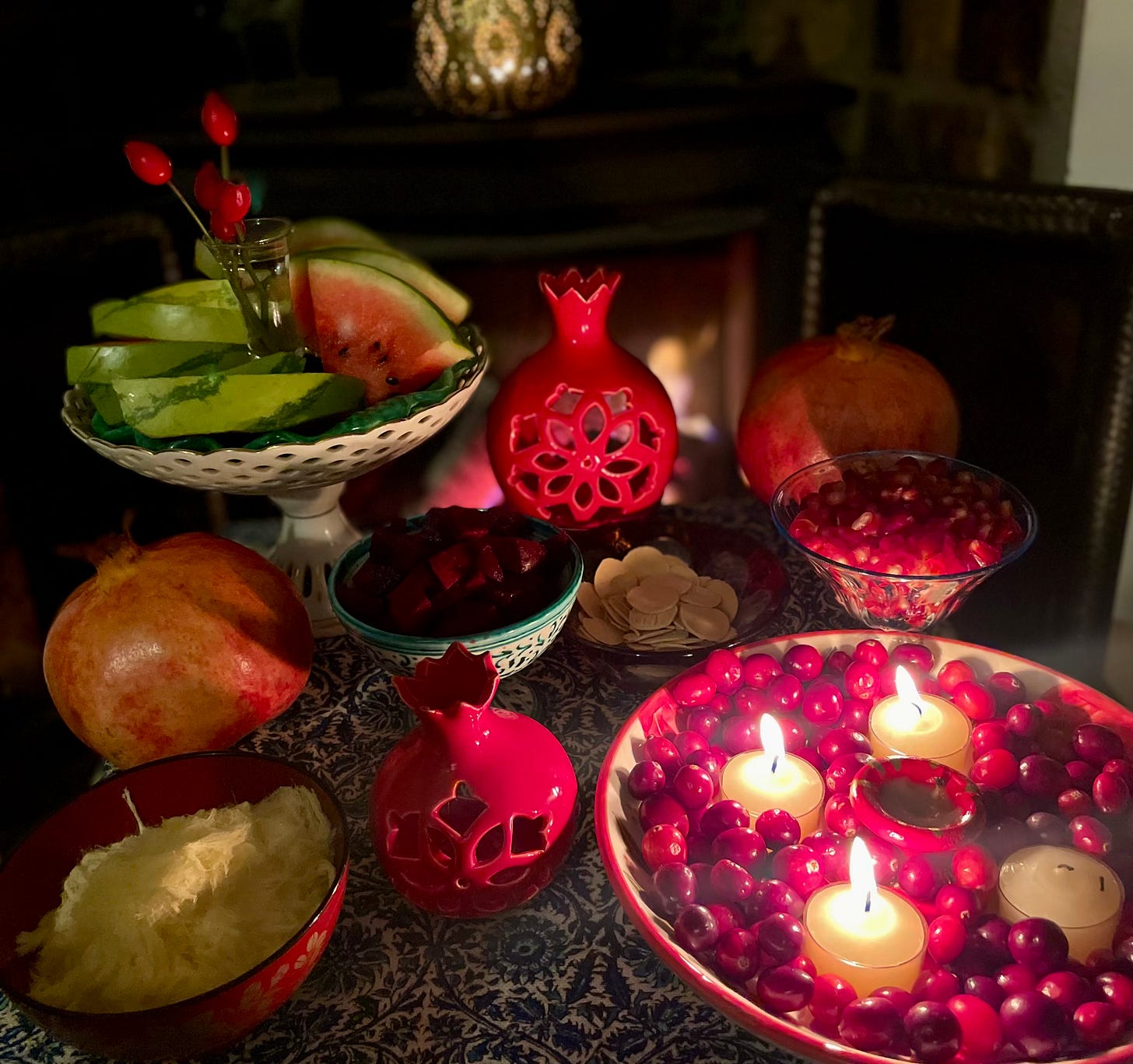
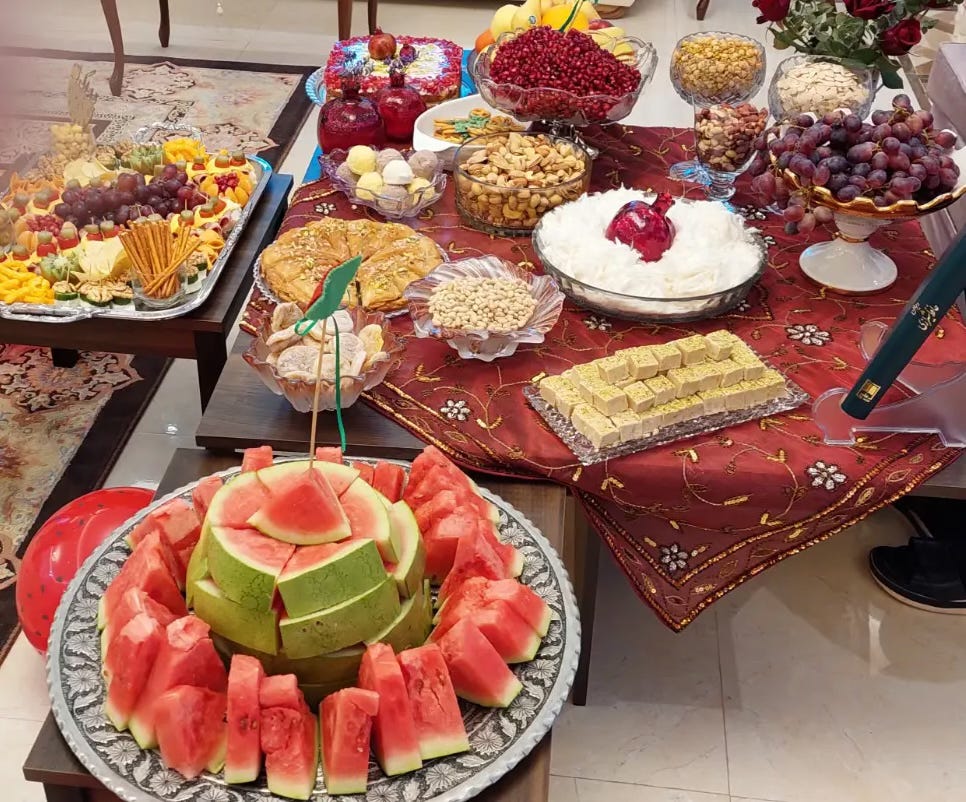
Besides the food, chilla jejasi is also a time for sharing interests. Whether it’s music, poetry, prose, films, science, or jokes, everyone contributes something. Some families play games, one such is game is topmaja or riddles.
O nadichi homini bazar ozi loot jazar? What dresses everyone but wanders around naked?
Answers in comment please.
In our home, my father’s friend’s poem Haydar Baba and Hafez would be recited, each family has their favourite poet. Another tradition is trying to glimpse into the future by fal tootmakh, bibliomancy. You think of a question or situation, then open a random page of Hafez’s Divān (a collection of his poetry). The poem you land on is read aloud and then everyone joins in to interpret it. It’s a fun way to connect with tradition, read poetry and have fun.
Across Azerbaijan, people are getting ready celebrating chilla jejasi, and it fills me with so much joy to know that these beautiful traditions are still alive. They keep family bonds strong within the country and help those of us far from home stay connected to our roots. These celebrations aren’t just about nostalgia, they’re a way to pass down ancestral traditions and ensure the next generation understands their cultural heritage.
Before COVID, I used to hold chilla jejasi with a group of women, we liked to think of ourselves as “blue stockings.” Each year, it was a slightly different group of fascinating women I’d met that year, all of whom I thought would enjoy it. Everyone brought something to share, whether food or poetry, prose, music, or dance. After the meal, we’d take turns sharing, reading, dancing, singing, or playing instruments. These gatherings were intimate, nourishing spaces for body and soul, filled with delicious food and even better company. I recently had a message from one of the women who attended which said:
.....it felt so rare and special and it was because of the people you brought together but also the way you made the space casual and special at the same time ....It’s hard to get the words right, I love meeting new people but it’s rare to have a group situation with strangers that is also intimate and not intimidating but also so interesting....
Examining global traditions during this time of year reveals parallels in universal themes of birth, hope, and light. The diverse names and interpretations of similar events, along with their unique customs, highlight both our shared human experiences and the rich variety in how these themes are expressed. This duality underscores a fundamental truth: humanity is more alike than different.
Wishing us all hope, light, warmth, and peace.
Here’s a quick, easy, and versatile recipe my students have loved in classes. It is equally delightful served warm or cold, as a side dish, or blended into a dip or soup. To take with you to a bring-and-share or enjoy at home.
Narli choondoor - Beetroot with Pomegranate Molasses
Ingredients
4 medium beetroot, boiled in their skins, then peeled
1 small garlic clove, mashed into a purée
2–4 tbsp pomegranate molasses (adjust to taste based on sweetness or tartness)
A pinch of dried thyme or 1 tsp fresh thyme (dried thyme needs time to soften in the dressing)
Salt, to taste
1 ½ tbsp olive oil
Optional toppings (to be added before serving):
Toasted coriander seeds or walnuts
Crumbled feta cheese
Method
Prepare the Beetroot: Boil, peel, and chop the beetroot to your preferred size. I recommend a 1 cm dice.
Make the Dressing: Mix half the garlic and the pomegranate molasses with all the olive oil, a pinch of salt, and a dash of pepper.
Combine: Toss the beetroot in the dressing, then taste it. Adjust the sourness, garlic, and salt as desired.
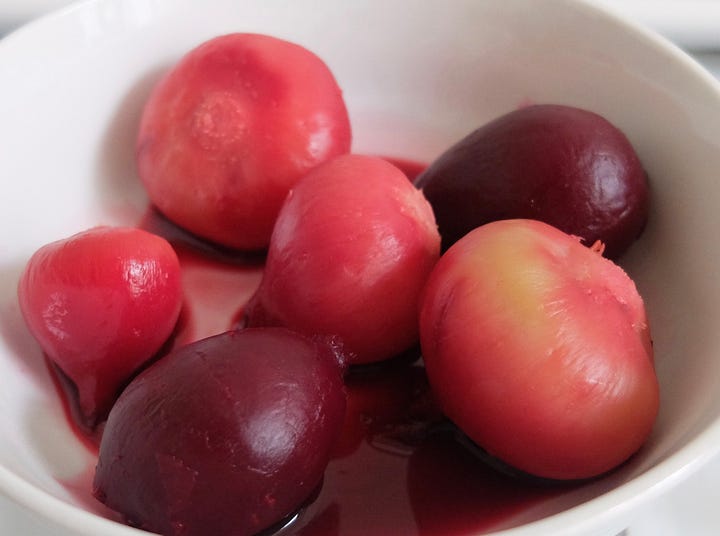
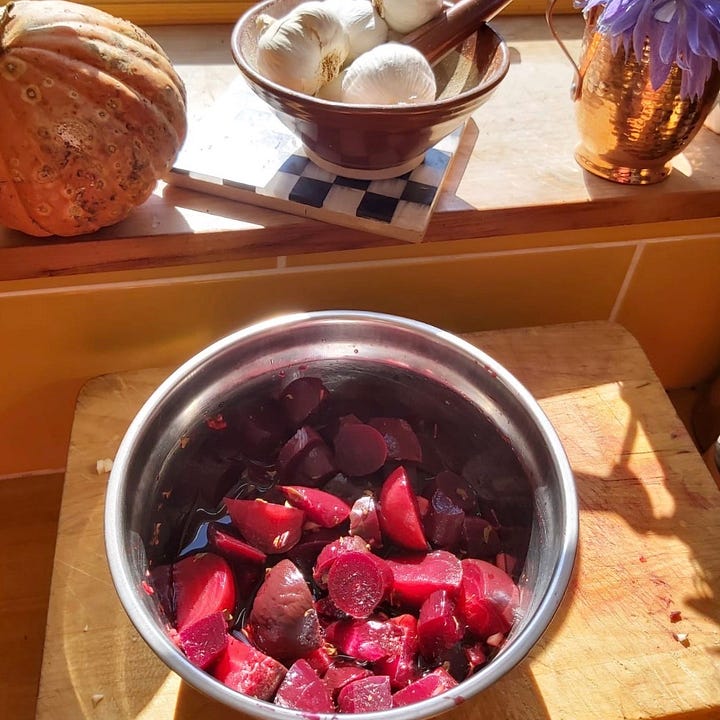
Rest and Serve: Allow the flavors to meld by leaving the dish to rest for a few hours or overnight. Serve at room temperature or chilled.
Additional Serving Options
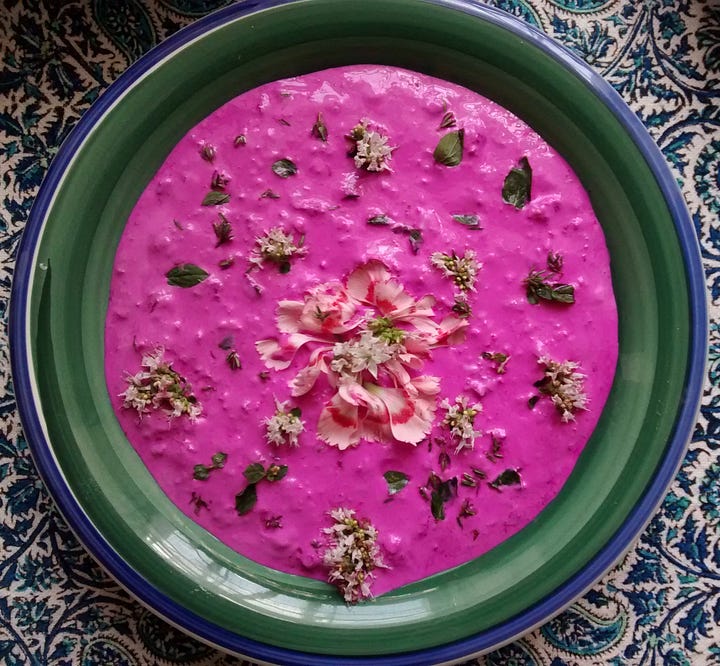

As a Dip: Blend the beetroot mixture until smooth. Adjust the seasoning, sprinkle with optional toppings, and serve with bread, crackers, or crudités.
You can also stir in strained yogurt for a milder flavor.
As a Soup: Blend the beetroot mixture in a pan and add homemade stock (I use chicken stock). Adjust the seasoning, sprinkle with toppings, and serve with bread and cheese.
Chilla's Aidin olsun
Did you solve the riddle?





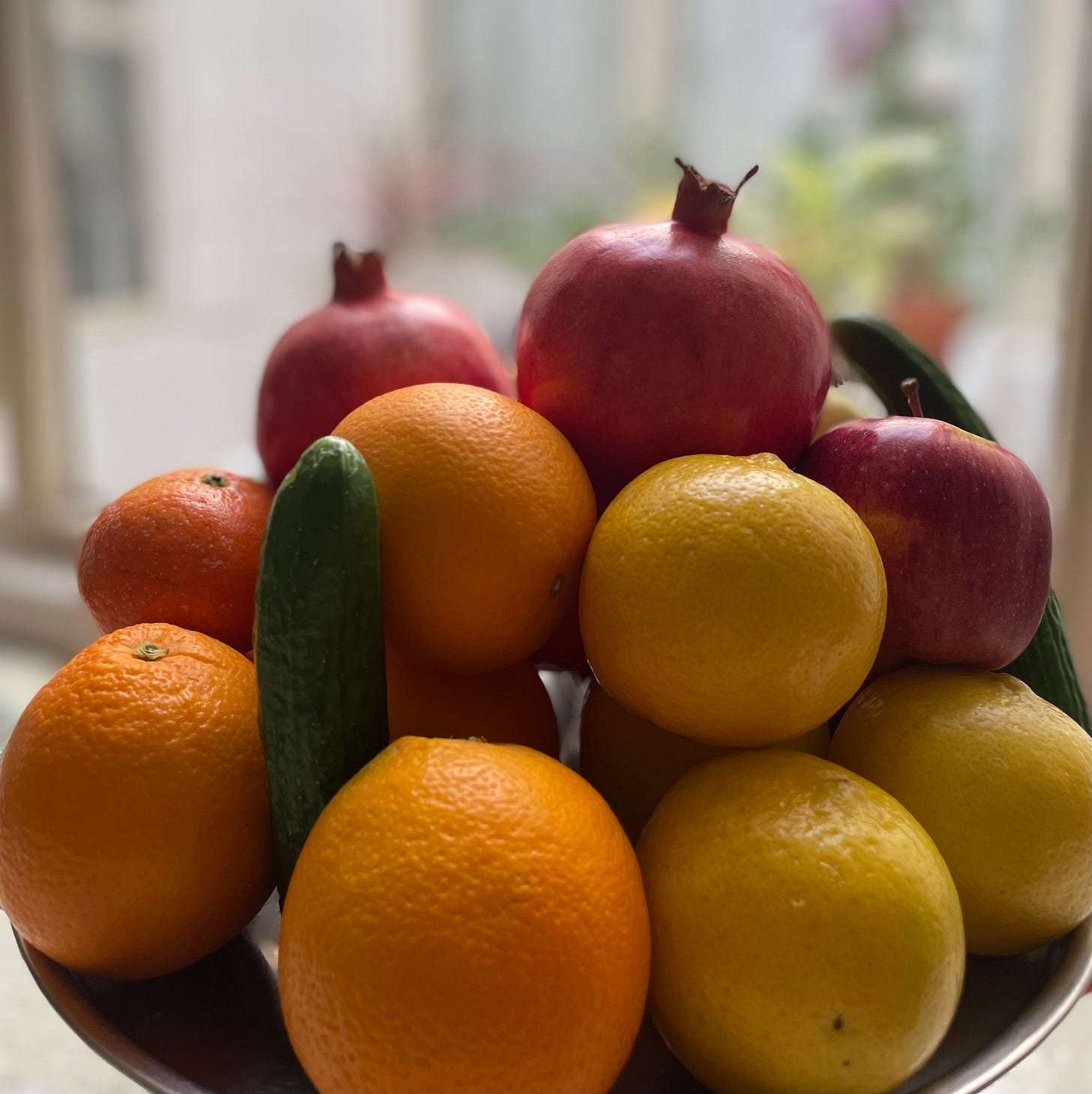

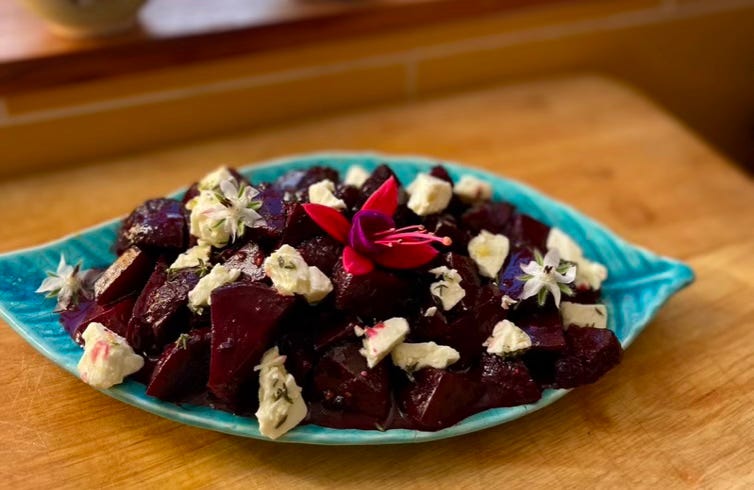
My current thought for the riddle is skin - everyone has a layer of it around them, but it is by definition itself naked. That may be too literal minded though! Could also be the dawn - which dresses you in the sense of telling you that you need to get dressed, but also is unclothed itself - certainly "naked as the dawn" is a phrase occasionally used in English.
Love, love, love reading this. Will not be making the recipe, however. Beetroot is the one food I absolutely loathe. I will be thinking of you as I make my solstice trip to the standing stones nearby...